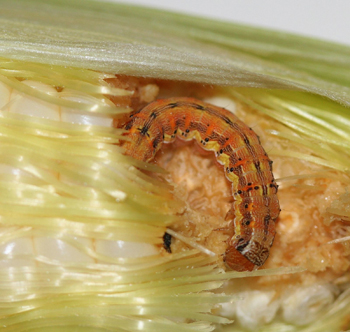Five years, 5000 Insects: Scientists Collaborate to Unravel Arthropod DNA
Published: February 6, 2018
By Daniel Gross

Genomic data from insects like the corn earworm (Helicoverpa Zea) may help farmers fight infestation (Photo: cyanocorax – Creative Commons).
Scientists are working together to map 5000 important insect genomes – online and worldwide.
By Daniel Gross
Entomologists across the globe have announced a project to map the genes of 5000 insect species in the next five years.
Members of the “i5K Insect and other Arthropod Genome Sequencing Initiative” are currently nominating species to study on a user-edited Wiki.
Species will be selected for their importance to fields like agriculture, medicine, energy, and biological research. The 100 nominated so far include pests like the destructive corn earworm and pollinators like the now-threatened honeybee.
By selecting a broad range of arthropods (which include insects and crustaceans), i5K could sharpen our understanding of taxonomy and evolution. Drawing from a range of classes of arthropods might clear up gray areas of classification, like where to place the extinct trilobite.
i5K could also have sweeping effects on insect control if it sheds light on disease transmission or chemical sensitivity. For example, sequencing could illuminate genes that code for “detox” enzymes. Knowing how insects resist a pesticide could help scientists improve it.
Its relevance to farming helps explain why half the project’s ten-person launch group is affiliated with the U.S. Department of Agriculture.
Kevin Hackett of the USDA’s Agricultural Research Survey told Living on Earth that i5K could target a swath of “societal challenges” like biofuel production and food safety, both of which are affected by pests. He added that some applications of i5K could be completely novel, like using understanding “insect roles in carbon sequestration and digesting methane” and using “arthropod sensory receptors as detectors for biodefense.”
But first, the project needs input from the scientists who can use this information. That means expanding beyond its current 129 members and connecting with entomologists already working on relevant projects. So far, scientists have signed on from Berlin and Taipei to Tel Aviv and Barcelona.
A similar project called Genome 10K started unspooling the DNA of 10,000 vertebrate species in 2009.
Professor of biology Susan Brown of Kansas State University told Living on Earth that project leaders envision yearly workshops and meetings to aid collaboration. She said right now, they’re setting standards and criteria for future sequencing.
Back to Living on Earth
Living on Earth wants to hear from you!
Living on Earth
62 Calef Highway, Suite 212
Lee, NH 03861
Telephone: 617-287-4121
E-mail: comments@loe.org
Newsletter [Click here]
Donate to Living on Earth!
Living on Earth is an independent media program and relies entirely on contributions from listeners and institutions supporting public service. Please donate now to preserve an independent environmental voice.
NewsletterLiving on Earth offers a weekly delivery of the show's rundown to your mailbox. Sign up for our newsletter today!
 Sailors For The Sea: Be the change you want to sea.
Sailors For The Sea: Be the change you want to sea.
 The Grantham Foundation for the Protection of the Environment: Committed to protecting and improving the health of the global environment.
The Grantham Foundation for the Protection of the Environment: Committed to protecting and improving the health of the global environment.
 Contribute to Living on Earth and receive, as our gift to you, an archival print of one of Mark Seth Lender's extraordinary wildlife photographs. Follow the link to see Mark's current collection of photographs.
Contribute to Living on Earth and receive, as our gift to you, an archival print of one of Mark Seth Lender's extraordinary wildlife photographs. Follow the link to see Mark's current collection of photographs.
 Buy a signed copy of Mark Seth Lender's book Smeagull the Seagull & support Living on Earth
Buy a signed copy of Mark Seth Lender's book Smeagull the Seagull & support Living on Earth

